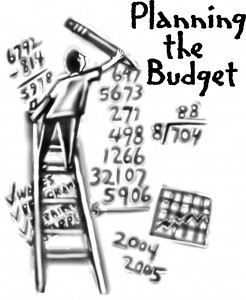A few weeks ago, I shared Financially Surviving COVID-19, a guide to financial literacy this period and everyone loved it; home and abroad. So, I’ve decided to dive a little deeper on all the steps mentioned to allow readers maximize their unique financial strategies.
This week is about budgeting!
Money can be so mathematical and uninteresting for most, including myself, so I’d be relating more about my personal experience to help you get through this post. For me, my biggest fear before I created a budget was the fact that I knew I was just vibing; and what I mean by that is that my income could in no way, shape or form fund the lifestyle I was enjoying so I was scared that once I put pen to paper all top that would somehow come to an end.
I dreaded creating a budget for the longest time but I eventually did because I realized that even national budgets sometimes at the point of review experience deficit. Which means countries and institutions spend money they don’t have. So it’s not just me? What a relief!
“A budget deficit occurs when expenses exceed revenue and indicate the financial health of a country.”
A budget is very important, it shows you the reality of your financial situation and helps you plan a recovery if things are already crucial or shows room for improvement if you are just getting by. A budget helps you track your income and expense and should always be paired with a financial goal.
See it like this: you have your financial goal for the year, your budget clearly shows the resources you have to meet that goal and the strategies you set to meet those goal will depend on the quality of information available.

How do you create a budget?
1. Set your goals:
Make a list of all the financial goals you want to accomplish in the short-and long-term. Your short-term goals should be the financial goals what you can achieve in less than a year. While the long-term goals, such as saving for retirement or your child’s education, may take years to reach.
It’s important to identify your priorities before you start planning a budget. For example, it may be easier to cut spending if you know your short-term goal is to double the savings of your rent money.
2. Note your Income:
The first step in creating a budget is to identify the amount of money you have coming in (salary or freelance) and remember to subtract your deductions, such taxes. Your final take-home pay is called net income/net earnings.
| Description | Value | Projection |
| Income I | 0 | |
| Income II | 0 | |
| Bonus | 0 | |
| Vacation Pay | 0 | |
| Allowance | 0 | |
| Side Hustle | 0 | |
| Other Income | 0 | |
| 0 | ||
| Income Tax | 0 | |
| Net Earnings | 0 |
3. Track your spending:
It’s also important to keep track of and categorise your spending so you know where you can make adjustments. This will help you identify what you are spending on the most and where it might be easiest to cut back.
Begin by listing fixed expenses – the regular monthly bills such as rent or mortgage, utilities or car payments. It’s unlikely you’ll be able to cut back on these, but knowing how much of your monthly income they take up can be helpful.
Next is to list all your variable expenses – those that may change from month to month such as groceries, gas and entertainment. This is an area where you might find opportunities to cut back.
| Description | Budget | Actual |
| Rent | 0 | 0 |
| Auto Insurace | 0 | 0 |
| Medical Insurance | 0 | 0 |
| Fuel | 0 | 0 |
| Depreciation | 0 | 0 |
| Savings | 0 | 0 |
| Investment | 0 | 0 |
| Internet Bill (Data) | 0 | 0 |
| Telephone Bill (Airtime) | 0 | 0 |
| Energy Bill (PHCN) | 0 | 0 |
| Eating Out | 0 | 0 |
| Subscriptions | 0 | 0 |
| Grocieries & Fruit | 0 | 0 |
| Personal Effect | 0 | 0 |
| Household Effects | 0 | 0 |
| Emergency Savings | 0 | 0 |
| Tithe | 0 | 0 |
| Miscellaneous | 0 | 0 |
| Annual Budget | 0 | 0 |
4. Make a plan:

Use the variable and fixed expenses you compiled above to help you get a sense of what you’ll spend on in the coming months.
- With your fixed expenses, you can predict fairly accurately how much you will have to budget for.
- Use your past spending habits as a guide when trying to predict your variable expenses.
Break down your expenses even further, between your needs and wants.
For instance, if you drive to work every day, fuel is a need. However, a monthly Netflix subscription may count as a want.
5. Adjust your habit if neccessary:
Once you’ve done all this, you have what you need to complete your budget. Having documented your income and spending, you can start to see where you have money left over or where you can cut back so that you have money to put toward your goals.
It’s important to cut back on wants to save and make minor adjustments where necessary.
6. Keep checking in:
It’s very important that you review your budget on a regular basis to be sure you are staying on track.
For example: You may get a salary raise at work – whatever the reason, keep checking in with your budget following the steps above.
Here’s a link to a demo sample I created on my Dropbox. Feel free to edit as needed. Fill the expense sheet and it would auto-populate to the budget.
Cowritten with our guest writer, Emmanuel Chukwure
Have a great weekend, and until next time,
Happy Economist.
🙂

Thanks for sharing learnt alot
LikeLike
Well done Tolu. Very detailed and informative
LikeLike
Thank you
LikeLike